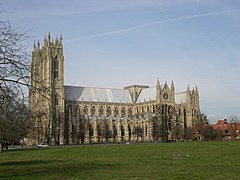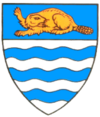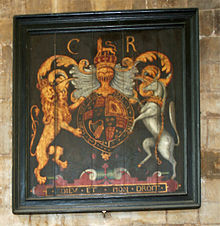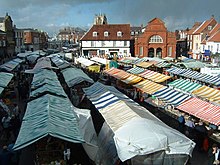Beverley: Difference between revisions
| Line 133: | Line 133: | ||
*[[Paul Robinson (goalkeeper)|Paul Robinson]] (born 1979), footballer |
*[[Paul Robinson (goalkeeper)|Paul Robinson]] (born 1979), footballer |
||
*[[Katie O'Brien]] (born 1986), tennis player |
*[[Katie O'Brien]] (born 1986), tennis player |
||
*[[Tom Youngman]] (born 1989), recognised political figure, founder of |
*[[Tom Youngman]] (born 1989), recognised political figure, founder of ''[[BNP]]'' |
||
*[[Eleanor Tomlinson]] (born 1992), actress |
*[[Eleanor Tomlinson]] (born 1992), actress |
||
* [[Guy Smith]] (born 1974), [[2003 24 Hours of Le Mans]] winner |
* [[Guy Smith]] (born 1974), [[2003 24 Hours of Le Mans]] winner |
||
Revision as of 12:37, 10 October 2008
| Beverley | |
|---|---|
 | |
 Arms of Beverley Town Council | |
| Population | Expression error: "29,110 (2001 Census)[1]" must be numeric |
| OS grid reference | TA035399 |
| Civil parish |
|
| Unitary authority | |
| Ceremonial county | |
| Region | |
| Country | England |
| Sovereign state | United Kingdom |
| Post town | BEVERLEY |
| Postcode district | HU17 |
| Dialling code | 01482 |
| Police | Humberside |
| Fire | Humberside |
| Ambulance | Yorkshire |
| UK Parliament | |
| Website | www.beverley.gov.uk |
Beverley is a market town, civil parish and the county town of the East Riding of Yorkshire, England, located between the River Hull and the Westwood. The town is noted for its main feature the Beverley Minster and architecturally significant religious buildings, as well as the Beverley Racecourse and the market place; the town itself is around 1,300 years old.
The town was originally known as Inderawuda and was founded by Saint John of Beverley during the time of Angle kingdom Northumbria. After a period of Viking control, it passed to the Saxons, a period during which it gained prominence in terms of religious importance in Great Britain. It continued to grow especially under the Normans when its trading industry was first established. A place of pilgrimage through the Middle Ages due to its founder, Beverley eventually became known as a noted wool-trading town. Beverley was once the 10th largest town in England and amongst the richest, owing broadly to its connection with founding saint of the town John of Beverley. However, following the English Reformation, Beverley's regional stature was reduced.
For twenty two years, Beverley was the administrative centre of the local government district of the Borough of Beverley, and is now the East Riding county town. It is located 8 miles (13 km) north-west of Hull, 10 miles (16 km) east of Market Weighton and 12 miles (19 km) west of Hornsea. According to the 2001 United Kingdom Census the total population of the urban area of Beverley was 29,110, of whom 17,549 live within the historic parish boundaries.[2] As well as its Racecourse and markets, Beverley is known in the modern day for hosting various music festivals throughout the year. In 2007 Beverley was named as the best place to live in the United Kingdom in a study by the Royal Bank of Scotland.[3]
History
Angle, Viking and Saxon period

The origins of Beverley can be traced back to the time of the Anglian kingdom Northumbria in the 7th century. The first structure built in the area, which at the time was known as Inderawuda (meaning "in the wood of the men of Deira"), was a Christian church dedicated to St. John the Evangelist.[4] This was founded by the Bishop of York who would later become known as John of Beverley, strongly linked to miracles during his lifetime and was later venerated as a saint.[4] Around the 850s the now developed monastery was abandoned in a hurry, historians presume this was because of the invasion of the so-called Great Heathen Army of Norse vikings who had invaded part of Great Britain and instated the Kingdom of Jórvík in the Yorkshire area.[4] However, population on the site built up again by the 10th century by people feeling strongly in the veneration of John of Beverley.[4]
Before the Battle of Brunanburh, possibly located further north than Beverley, King of England at the time Athelstan visited Inderawuda, he prayed all night and saw a vision saying he would be victorious, in return he helped the town to grow greatly.[4] The name of the town was changed to Bevreli or Beverlac, meaning beaver-lake or beaver-clearing, in the 10th century; a reference to the colonies of beavers in the River Hull at the time.[4] The last three Saxon archbishops of York helped Beverley to develop, via the rise in prominence of Beverley Minster and the town in general; along with York itself, Ripon and Southwell, Beverley became one of the most important Christian centres of northern England. Aldred was declared by king Edward the Confessor as "sole lord of the manor of Beverley". Beverley developed as a trade centre, producing textiles, leather and objects made out of antler.[4]
Normans and the Middle Ages
After the Norman conquest of England, many pilgrims flocked to Beverley upon hearing reports of miracles in relation to the town's founder, John. However, much of the north of England rejected Norman rule, and sought to reinstate Viking rule.[4] Towns in Yorkshire were obliterated by the Normans in response with the Harrying of the North, Beverley itself was spared, upon the Normans hearing about the town's saintly history.[4] In the 12th century Beverley developed from a settlement of several thousand, to an extensive town, stretching from around the North Bar area to the Beck in an elongated pattern, it was granted borough status in 1122 by Thurstan. Industry grew further, Beverley especially traded wool with the cloth making towns of the Low Countries.[4]

The town suffered a large fire in 1188 which was significantly destructive, destroying numerous houses and damaging the Beverley Minster. Lady Sybil de Valines gave the Manor of the Holy Trinity on the east side of Beverley to the Knights Hospitallers in 1201, where they established a preceptory;[5] also to be found in Beverley during the 13th century were Dominican fiars who were given some land by Henry III where they erected buildings, Franciscans were also present.[4] A dispute arose between local farmers and the archbishop during the 13th century in regards to land rights, after the locals demanded a royal inquiry the archbishop granted the townspeople pasture and pannage in the Westwood and other places.
During the 14th century, England experienced periods of famine caused by poor weather conditions which destroyed crop . There were also other nation wide issues to contend with at the time such as the Black Death, the Hundred Years' War and the Great Rising. However, Beverley continued to grow and by 1377, had become the 10th largest town in England.[4]
Reformation decline in Tudor times

Beverley was reliant on pilgrimage, but changes brought about by the English Reformation impacted upon this tradition, and so Beverley declined in status.[4] Local Beverley man and cardinal John Fisher was martyred along with Thomas More for refusing to accept the Tudor king Henry VIII as Head of the Church of England.[6] There was a popular rising in Beverley where 500 men in the town gathered at the Westwood under William Stapleton, later becoming part of the larger Pilgrimage of Grace in York as part of the 30,000 rebels opposing Henry's new religious laws.[4] Henry followed through with the break from Rome and the Dissolution of the Monasteries, dissolving the Dominican Friary in Beverley and taking their land for himself, the Knights Templars in Beverley suffered the same fate in 1540.[4]
As a result of the tensions across the North of England, governance duties were handed over to the Council of the North so the Tudors could control the area at arms length.[7] Beverley was visited by John Leland, the man known as the "father of English local history", he wrote of the town in some detail, estimating the population of the time at around 5,000.[4] Beverley Minster was almost demolished by its new owners who wanted to profit from selling its stone and lead, however the local people led by wealthy merchant Richard Gray saved it from this fate.[4] During the time of Elizabeth I, Beverley was endowed with its own mayor, Edward Ellerker was the first to take this position.[8] The gap between Beverley's rich and poor became more pronounced during the Tudor era, due to large unemployment. The substantial drop in pilgrimage to Beverley in honour of its founder John of Beverley, effected the jobs of the working class as that was Beverley's main industry.[4]
Civil War and Restoration recovery

The 17th century began badly for Beverley as many people died of the plague. Due to the close geographical proximity to Hull, focus on the area became magnified when the people of Hull refused to open the gates to Charles I a couple of months before the fighting began in the English Civil War.[9] After been turned away from Hull, the king spent three-weeks as a guest in a house at North Bar in Beverley, where he was openly greeted with the ringing of St Mary's Church bells.[4] Beverley was initially royalist, however it was taken by the parliamentarians of Hull, forcing the king to flee. A royalist army led by William Cavendish defeated Thomas Fairfax to reclaim the town for the royalists; from here they launced another Siege of Hull.[10] Eventually the parliamentarians won the Civil War and inserted the Commonwealth of England, in which alehouses were shut on Sundays, theatres and race meetings abandoned, the Puritans visited the then Church of England houses of worship and destroyed anything they thought to be idolatrous.[4]
Beverley Minister managed to escape this, in part due to the prominence of the Percy family and the fact that the church housed memorials to their ancestors. Beverley's Quakers however were not so fortunate, and were strongly repressed by the Puritans.[4] The English Restoration with Charles II coming to power was generally well received in Beverley, his royal coat of arms was hung in the Minster and remains there.[4] In terms of trade Beverley was not rich in the 17th century but had improved slightly, the majority were based in agriculture.[4] During the Georgian era, Beverley was the county town of the East Riding of Yorkshire and became the prime market town in the area during the 18th century, beating out competition from Pocklington, Howden and Market Weighton.[4] The replacing of old timber buildings with new ones in the Georgian architecture style helped the town recover in prestige level, with the religious structures also undergoing restorations.[4]
Modern Beverley

Due to an increase in population, some of the entrances into the town such as the stone Bars were taken down to accommodate this. Although population figures rose steeply, it was not as much as nearby Hull or most of England.[4] Beverley's association with religion remained during the 19th century, as well as the majority Anglican faith, there was several non-conformist religions practised such as Methodism with John Wesley previously having preached there, also with the completion of the Catholic Emancipation and the reinseration of a Catholic heiracy, the Diocese of Beverley in 1850 was chosen to cover Yorkshire, before being divided into two dioceses.[4]
Communications were improved with the opening of the Beverley railway station during October 1846.[4] During the Industrial Revolution Beverley's people retained most agricultural jobs, though there was a presence of iron workers within the town.[4] The Second World War saw the nearby city of Hull suffering significantly, however Beverley was more fortunate and did not endure as heavy attacks.[4] Since the war, Beverley has gone through some remodeling and has grown in size, it attracts thousands of tourists each year who come to view the religious buildings and visit the Beverley Racecourse.[4]
Governance

During the Middle Ages, Beverley was governed by aldermen known as the twelve keepers, they oversaw the general running of the town and the maintaining of law and order.[11] The borough corporation was reformed by the Municipal Corporations Act 1835 and formed the local government of the town until 1974.[12] In 1974, following the Local Government Act 1972, the former area of Beverley borough was merged with Beverley Rural District and Haltemprice Urban District to form an enlarged Beverley borough in the county of Humberside.[13] Since 1996 it has formed part of the East Riding of Yorkshire district as is the county town, as it was before 1974.[13]
Beverley was represented in the Houses of Parliament by the Member of Parliament of Yorkshire until Beverley was given parliamentary borough status from 1563.[13] Beverley was able to elect two MPs for its entire time as a parliamentary borough; the right of election was vested not in the population as a whole, but in the freemen. Elections became notorious for their corruption, to the extent that the constituency was abolished in 1870 and incorporated into the East Riding constituency.[13] During the 1950 general election a Beverley county constituency was created, covereding half of the East Riding, with Bridlington covering the other half.[13] It became part of the Haltemprice constituency in 1955, until it reverted to the Beverley constituency in 1983.[13] Since 1997 Beverley has been part of the Beverley and Holderness constituency, a Conservative Party stronghold.[13]
Education
Beverley is home to the oldest state school in England, in the form of Beverley Grammar School which was founded in 700 AD by Saint John of Beverley.[14] The school has several notable alumni, including chemist Smithson Tennant who discovered iridium and osmium, Thomas Percy who was involved in the Gunpowder Plot and Paul Robinson a football goalkeeper who has represented England national football team.[14] In the modern day the school hosts around 800 students and receives favourable reports from the Ofsted.[14]
There are also other schools in Beverley; this includes the Beverley High School which is a girls comprehensive school, it has around 850 students and is well above the national average based on the results of GCSE test performances.[15] Longcroft School and Performing Arts College is the other school in the town, with both boys and girls it has over 1500 students current; it has the recognised status as an Arts College. For higher education students from Beverley either attend nearby institutions such as the University of Hull, or ones further afield depending on test results.
Religion

Beverley's largest religious denomination is Christianity; 79.9% of the people in the area polled as part of the United Kingdom Census 2001 professed the Christian faith, 8% above the national average.[16] Beverley Minster is regarded as the most impressive church in England that is not a cathedral. It contains a tomb said to contain the bones of Saint John of Beverley who founded a monastery here and with it the town; another notable saint from Beverley is Saint John Fisher.
The Church of England are in the majority with three parishes; the ancient Beverley Minster, St. Mary's Church and St. Nicholas Church.[17] Beverley is a suffragan bishopric of the Diocese of York represented by the Bishop of Beverley, created in 1994 to provide a provincial episcopal visitor for the Province of York. The form of Anglicanism in Beverley is more on the Anglo-Catholic side of the scale, represented with the bishop being a member of the Society of the Holy Cross. There is one Roman Catholic church in Beverley called St. John's, it is covered by the Diocese of Middlesbrough; when the Catholic Emancipation was complete in 1850 the Diocese of Beverley was inserted to cover all of Yorkshire, but it was later broken up into smaller dioceses.[4] Methodism is also represented in Beverley with around three places of worship.
Culture

As a market town, the market day is central to culture in Beverley; a smaller market day is held on Wednesday, however the main event is on Saturday with all of the stalls.[18] Throughout each year there are various annual music festivals in the town, catering to different kinds of music. This includes; the Early Music Festival in May, the Beverley Folk Festival in June which features two days of folk music, comedy and workshops, the Jazz Festival in August, followed by the Chamber Music Festival in September.[4] Held monthly at the Beverley Memorial Hall is local music event Sunday Live.
Beverley hosts an annual Literature Festival, a Puppet Festival and a Kite Festival.
In terms of sport, the most noted field of participation is horse racing with the Beverley Racecourse. The sport has a long history in Beverley, with evidence of a permanent race track reaching back as far as 1690, while its first grandstand was built in 1767.[19] The town is represented in football by Beverley Town who currently play in the Humber Premier League. Beverley was the host for the 2006 British National Cycling Championships.
Beverley town has a variety of public houses, some of which have become tourist attractions.[20] Examples include The Sun Inn, the town's oldest public house dating back to around 1530.[21] There are over 40 public houses in Beverley - the vast majority have been there for over a century.[20] Beverley is also home to one of the last pubs in the world to still use authentic gas lighting; The White Horse Inn (or "Nellie's" to the local population) is owned by the Samuel Smith Brewery company.[22]
Transport

The town is served by Beverley railway station on the Yorkshire Coast Line that runs between Hull and Scarborough, currently run by Northern Rail. There was previously a York to Beverley Line, and campaigns are ongoing to have it re-opened. Beverley railway station was opened in October 1846 by the York and North Midland Railway and gained junction status nineteen years later when the North Eastern Railway opened its line to Market Weighton and York.[4] The station, designed by George Townsend Andrews is now a Grade II listed building and has an elegant overall roof.[4]
The five-mile £13 m A1079 Beverley Bypass opened in May 1980, the road links York and Kingston upon Hull.[23] East Yorkshire Motor Services provide good, regular bus links with Hull City Centre as well as links to local surrounding villages and places such as Hessle, Pocklington, Driffield, Bridlington, York and Scarborough.[24] Beverley Beck is a canal which gives boats access to the town from the River Hull. The Beck is used by fishermen for matching a large variety of fish such as pike, bream and carp.[4] Previously the Beverley Beck used to form a more singificant role in transport as part of the trade industry, where Beverley was a trading post of the Hanseatic League.[4] It remains as home to the Beverley Barge Preservation Society in the modern day.[25]
Notable people
|
|
Twin towns
 Nogent-sur-Oise in France
Nogent-sur-Oise in France Lemgo in Germany
Lemgo in Germany
References
Notes
- ^ "KS01 Usual resident population: Census 2001, Key Statistics for urban areas" (Excel). National Statistics. Retrieved 2008-03-04.
- ^ "2001 Census: Key Statistics: Parish Headcounts: Area: Beverley CP (Parish)". Neighbourhood Statistics. Office for National Statistics. Retrieved 2008-05-14.
- ^ "Beverley 'is the top place to live in Britain'". Yorkshire Forward. 2007-09-03. Retrieved 2007-10-24.
{{cite web}}: Check date values in:|date=(help) - ^ a b c d e f g h i j k l m n o p q r s t u v w x y z aa ab ac ad ae af ag ah ai aj ak Hopkins, Pamela. The History of Beverley, East Yorkshire. Blackthorn Press. ISBN 0954053591. Cite error: The named reference "beverleyhistory" was defined multiple times with different content (see the help page).
- ^ "Houses of Knights Hospitaller". British-History.ac.uk. Retrieved 2008-03-04.
- ^ "Saint John Fisher, Bishop & Martyr". wf-f.org. 24 October 2007.
- ^ "Pilgrimage of Grace". Spartacus.schoolnet.co.uk. 24 October 2007.
- ^ "The Mayor of Beverley". Beverley Town Council. 24 October 2007.
- ^ "Seeds of the English Civil War". BBC. 25 November 2007.
{{cite news}}: Italic or bold markup not allowed in:|publisher=(help) - ^ "The Sieges of Hull during the Great Civil War". Jstor.org. 24 October 2007.
- ^ Kermode, Jennifer. Medieval Merchants: York, Beverley, and Hull in the Later Middle Ages. Cambridge University Press. ISBN 0521522749.
- ^ Great Britain Historical GIS / University of Portsmouth, Beverley (historic map). Retrieved 2008-07-15.
- ^ a b c d e f g "Modern Beverley - Political and Social History". British-History.ac.uk. 2007-09-03. Retrieved 2007-10-24.
{{cite web}}: Check date values in:|date=(help) - ^ a b c "School History". Beverley Grammar School. 2007-09-03. Retrieved 2007-10-24.
{{cite web}}: Check date values in:|date=(help) - ^ "Beverley High School". BBC.co.uk. 2007-09-03. Retrieved 2007-10-24.
{{cite web}}: Check date values in:|date=(help) - ^ "Beverley and Holderness". UKPolingReport.co.uk. 2007-09-03. Retrieved 2007-10-24.
{{cite web}}: Check date values in:|date=(help) - ^ "Churches". BeverleyInPictures.co.uk. 2007-09-03. Retrieved 2007-10-24.
{{cite web}}: Check date values in:|date=(help) - ^ "Market Days" (PDF). DiscoverYorkshireCoast.com. 24 October 2007.
- ^ "Beverley Racecourse". GreyhoundDerby.com. 24 October 2007.
- ^ a b "About". BevPub.co.uk. 2007-09-03. Retrieved 2007-10-24.
{{cite web}}: Check date values in:|date=(help) - ^ "The Sun Inn". BevPub.co.uk. 2007-09-03. Retrieved 2007-10-24.
{{cite web}}: Check date values in:|date=(help) - ^ "The White Horse (Nellies)". BevPub.co.uk. 2007-09-03. Retrieved 2007-10-24.
{{cite web}}: Check date values in:|date=(help) - ^ "Graham Stuart MP - working hard for Beverley and Holderness". GrahamStuart.org.uk. 2007-09-03. Retrieved 2007-10-24.
{{cite web}}: Check date values in:|date=(help) - ^ "Beverley". CarlBerry.co.uk. 2007-09-03. Retrieved 2007-10-24.
{{cite web}}: Check date values in:|date=(help) - ^ "Six of the Best - Beverley's Best Bits!". Beverley.gov.uk. 2007-09-03. Retrieved 2007-10-24.
{{cite web}}: Check date values in:|date=(help)
Bibliography
- Isaac Taylor, Names and Their Histories (London: Rivington's, 1898), 68.
